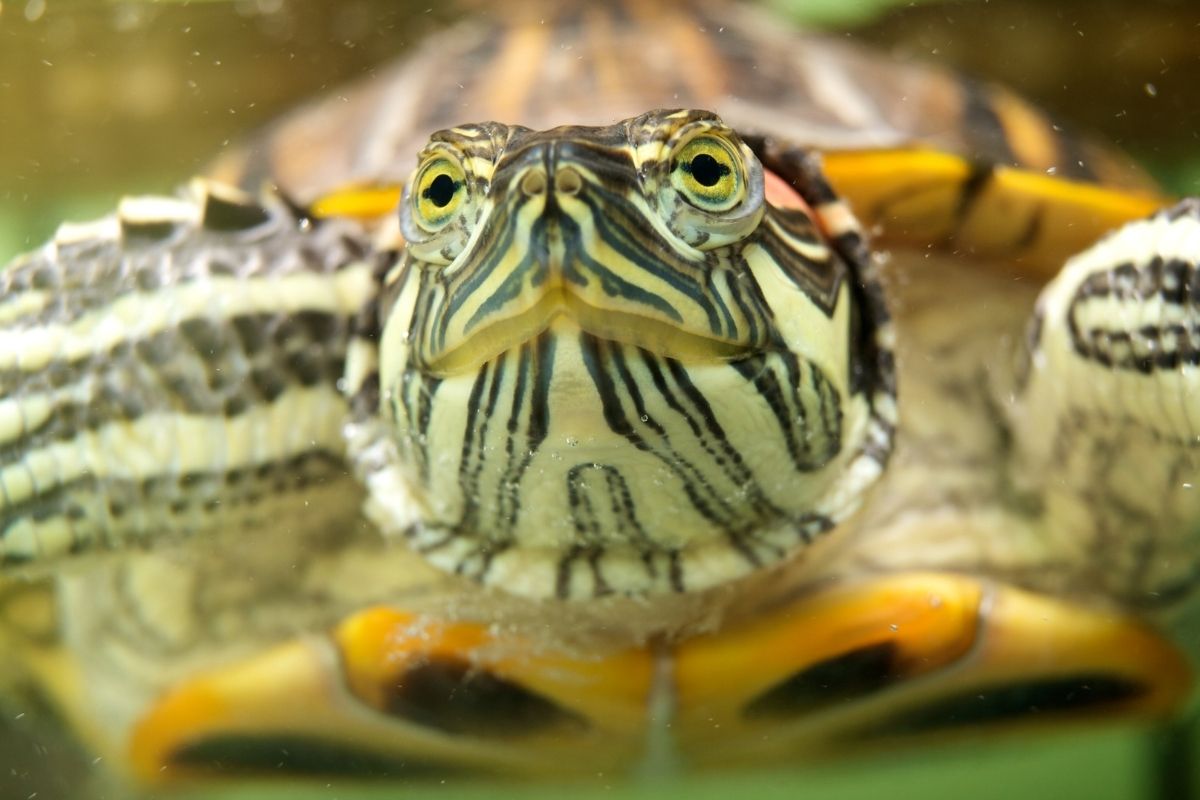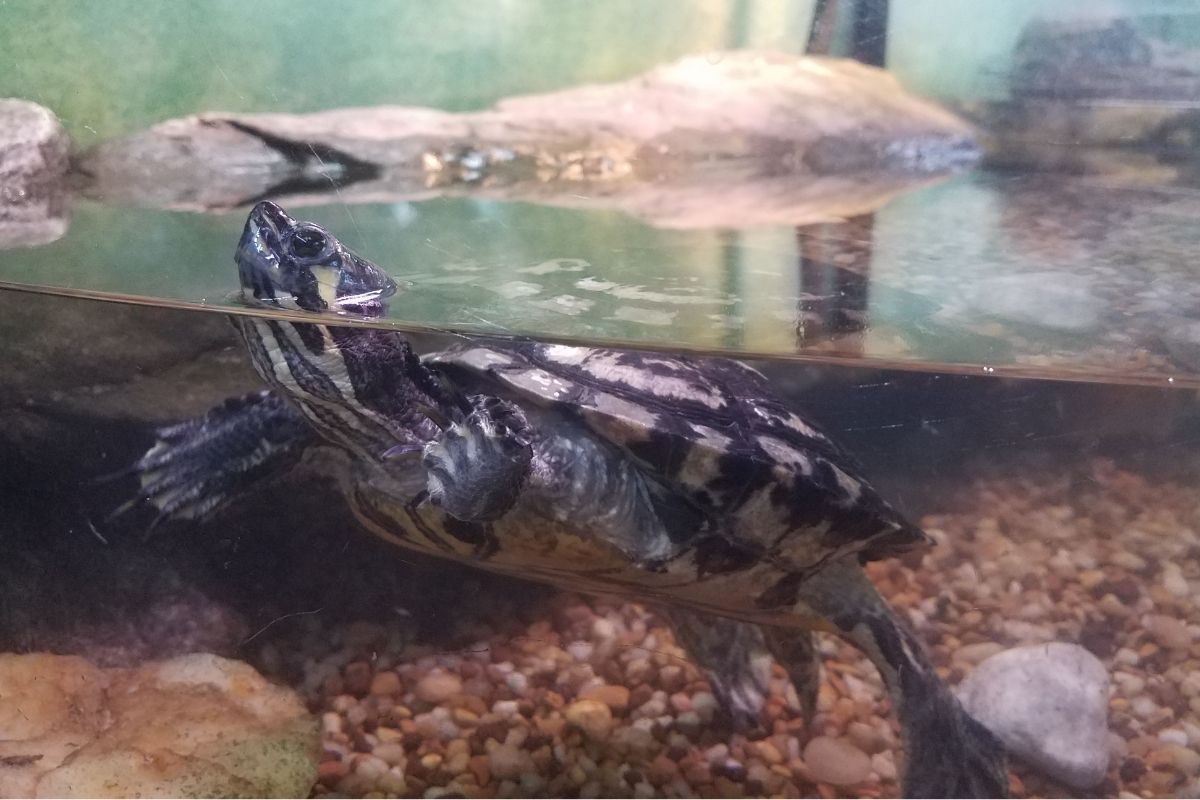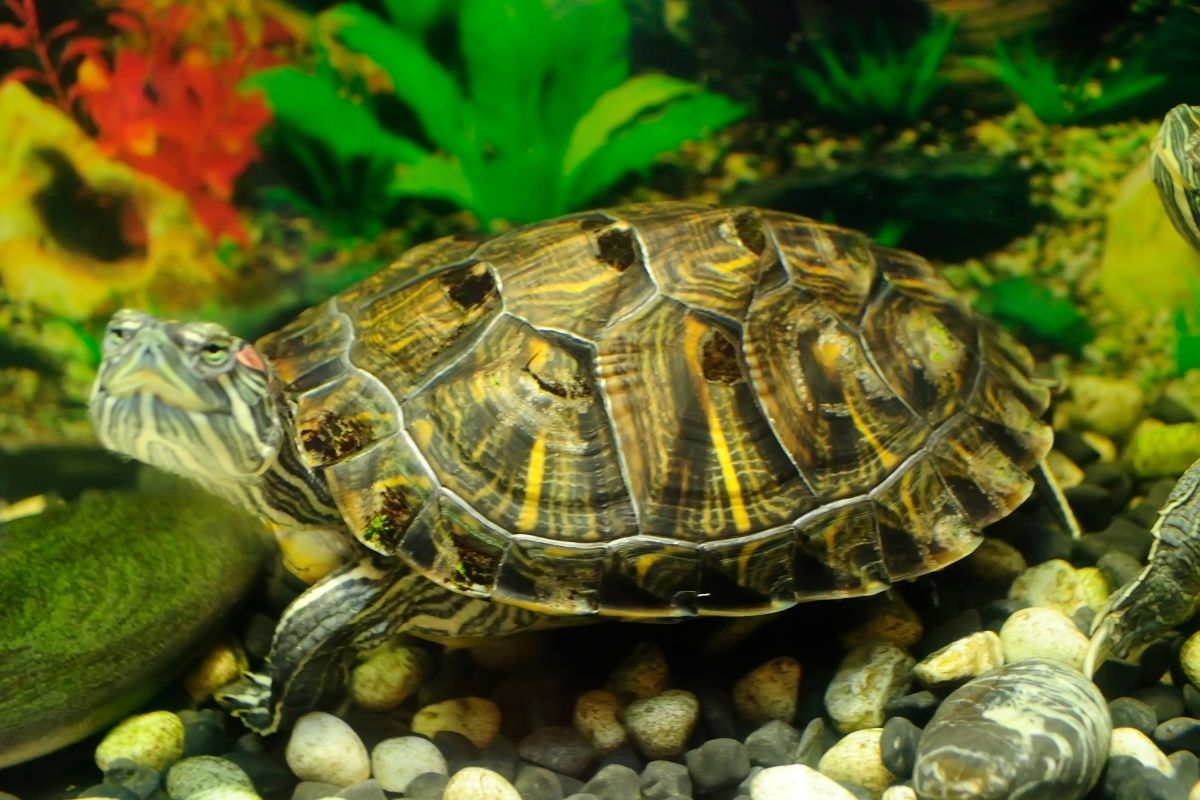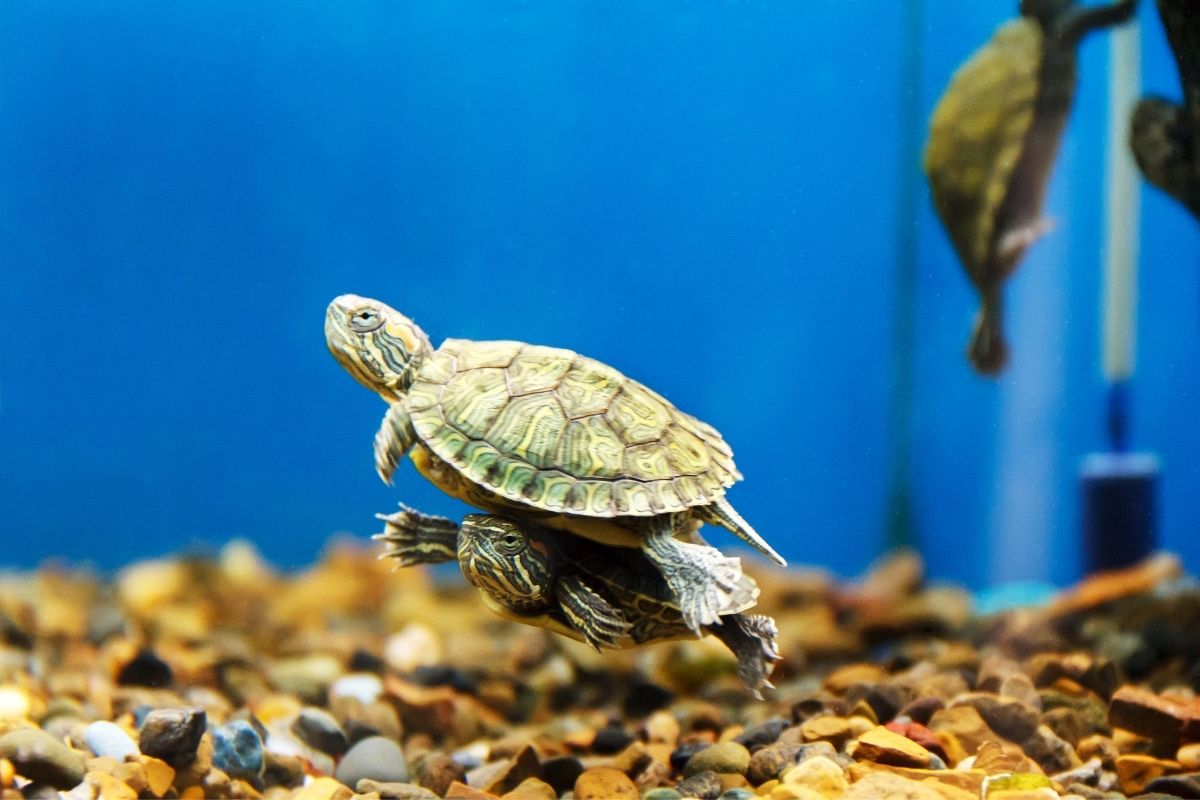Turtles are reptiles that live in the oceans. They eat plants and insects, lay eggs and reproduce by laying them in sand or mud. They are very slow-moving animals that do not move much.

Turtles that are kept as pets are often placed in aquariums and should be kept in a dark place and they shouldn’t be left alone for too long. Aquatic turtles need fresh water to survive.
Freshwater should be provided by an aquarium or other container and the water should be changed every few days.
This is because their excrement contains many bacteria and when the turtles drink the water they are also taking in the toxins from the water.
Turtles that live in their natural environment such as lakes tend to live longer as lakes contain good bacteria that rids the water of the bad stuff.
You should provide turtles with fresh water every day as well as make sure they have plenty of room to swim around.
Tank Size
Turtles need about 10 gallons of water per inch of the shell to survive. A 40-gallon tank is too small for a growing turtle. Get a 60 gallon or larger tank. Turtles grow slowly as they age, but they will still continue to grow.
You can’t go too far wrong when buying a turtle tank. Get the biggest tank you can afford and you should be fine.
If you shop around you should find a good quality tank that is very easy to maintain, with a simple filtration and heating eating system. Many come equipped with an automatic light timer that allows you to set your time schedule.
Good Filter/Plants
Water filters are important because they help keep the water clean. A water filter is usually rated by how many gallons of water it can handle.
For example, a 40-gallon filter is designed to be used in a 40-gallon tank.
A 60-gallon filter is designed to work in a 60-gallon tank. And a 120-gallon filter is designed for a 120-gallon tank. It is highly recommended to use a water filtration system because it helps your fish stay healthy.
Adding plants to their tanks helps remove nitrate and other pollutants from the water.
Plants also absorb CO2 and reduce algae growth. However, adding too many plants will cause algae blooms. So you should add plants slowly and monitor them closely.
UV sterilizers kill algae, most bacteria and many viruses, fungi and parasites and are a great addition to any aquarium.
They help keep the water clean and free of floating algae. They kill germs that can make the water smell bad, and they help keep the tank healthy by keeping the water clear.
They shouldn’t be used during initial water changes, but should be left on while adding friendly bacteria supplements, and should be turned off for a few days after replacing filters or changing the media inside
Changing Tank Water

Turtles need to be taken out of the tank once in a while. This helps keep the water cleaner for longer periods of time.
Algae grow on the sides of the tanks, and magnets help remove the algae. Unplugging the heater allows you to clean it and a siphon is used to remove water from a tank.
You should move the siphon around the tank while taking water out to prevent any algae from growing back. After you are finished, put the sponge into the freshwater to keep it clean.
Cleaning the tank is very important. Change the water every week or two. You must make sure that there are no debris or deceased fish in the tank as this will definitely compromise the water purity.
Water is also vital for turtles because they can’t digest food without water. They also need to stay in the water to keep themselves hydrated.
Cold-blooded creatures rely on their surroundings to regulate their body temperatures. As well as making sure that the water in your tank is always clean, you should also make sure that the temperature is right.
Water Quality
Tap water is unhealthy for turtles. Regular tap water contains harmful chemicals such as chlorine. Dechlorinating your tap water before adding it to your turtle’s tank is essential. You can buy water conditioners to do this for you.
Cleaning your turtle’s aquarium is important to help prevent illness. Regularly replacing some of your turtle’s water with fresh water helps to dilute waste in the tank.
A good rule of thumb is to purchase filters that are rated for tanks larger than your current tank.
As we’ve seen turtles need water to stay healthy. Turtles can live without water for a short while but not for long. Water determines how long turtles can stay in the water.
Factors that determine how long turtles can survive without water include temperature, humidity, and air pressure.
Most species of turtles thrive in water. They are able to survive without water by going into hibernation.
The amount of time they can stay outside water depends on the species, age, hibernating, and weather conditions. Let’s look at this in a bit more detail.
Turtle Species
Turtle species determine how long they can be outside water. Sea turtles spend most of their lives underwater, but some marine turtles come onto land to lay their eggs. Then they return to the ocean.
Turtles use their shells to protect themselves from predators. Red-eared sliders are the most common turtle found in North America.
These turtles live in ponds or lakes and eat fish and other aquatic creatures. They have sharp claws and teeth to help them catch prey and stay near water most of the time.
Land-dwelling turtles can live out of the water but not very long.
Age And Hibernation

Turtles need to be kept warm in order to stay alive. Young turtles do not have enough energy to stay outside water for very long so will end most of their time in the water.
Older turtles have more energy than younger ones so can survive longer on the land.
Turtles hibernate for about two to five months. They hibernate in the winter when it gets cold. They sleep most of the time when they’re hibernating and their metabolism slows down while they’re sleeping.
During hibernation, they don’t need water. They store up energy in their bodies before they go into hibernation.
When turtles hibernate, they can sleep outside of water without any problem. Their blood temperature drops down to about two degrees Celsius when they hibernate and this helps them survive the winter.
Climate
Climate plays a vital role in determining how long a turtle can stay outside water. Turtles need to come back into the water when the temperature gets too high.
In hot climates, turtles may get dehydrated and become ill if they spend too much time out of water.
Turtles need to be kept in a humid environment. Dry air causes turtles to dehydrate quickly.
Humidity levels should be maintained at around 80%. A turtle needs to be checked every 4-6 hours if it spends long periods of time outside the water.
The Best Water
Aquatic turtles need distilled water because tap water contains impurities that may be harmful to them. Distilled water is free of impurities, and is safe for the turtles.
Tap water should be treated before drinking. To do this, boil it for five minutes. This kills bacteria and viruses. You can also add chlorine or iodine to make it safer. Chlorine makes tap water taste bad. Iodine doesn’t change the taste.
Your municipality probably adds other chemicals in drinking water to make transmission and storing easier. You should use a reptile-specific water conditioner.
If you decide your tap water isn’t good enough, you can use a water conditioning system (easiest and probably safe). Or you can just let the water sit overnight in a large container. The sunlight will help dissolve the chlorine.
If you have a particularly sensitive turtle then it should drink distilled and filtered water because it doesn’t contain chlorine or any additives found in tap water, and it won’t affect their PH levels. How else can you dechlorinate water?
Dechlorinating Water

A popular way to filter your water is through a pitcher filter. This removes chlorinated water by filtering your drinking water through a pitcher filter kept in the refrigerator.
There’s also an alternative method of getting rid of chlorine and this is by using a water filtration system attached to your tap.
Always remember to change filters regularly for maximum effect. A granular activated carbon filter removes bad odors and tastes from tap water and is easy to install.
Reverse osmosis water filtration systems are used to remove almost all of the chemicals from the water that enters your home. If you do some research and shop around, these systems are relatively inexpensive.
Chlorine evaporates away from the water over time. Fill a bucket or tub with your water, and do not cover it. Place it in an area with less airborne particles and debris, such as a basement or garage.
Check the water regularly using a test kit to determine how many milligrams of chlorine remain in the water.
Evaporation doesn’t remove chloramine, which can be found in some water supplies. Chloramine isn’t recommended for drinking water because it can contaminate it.2+13Ultraviolet light is used to dechlorinate water by removing both chlorine and chloramines.
Chlorine levels must be reduced before chloramines can be removed.
Typically, you should treat chlorines with UV light at the 254 nm wavelength that has a radiant energy density of 600 mW/cm2. Water treated with UV light will contain less than 0.1 mg/L of free chlorine residuals.
Temperature
Turtles should be kept in a heated environment to avoid hypothermia. Heated aquariums are needed to keep them warm. Heaters must be powerful enough to heat the entire volume of water in the tank. Higher wattage means more heat.
For example, if you have 100 gallons of water in a tank, then you need a heater with 150 watts.
Submersible aquarium heaters should be placed an inch or two below the surface of the tank’s water. Make sure to turn them off when doing water changes if there’s a chance that the water level could drop below that of the heaters.
You should choose an aquarium heater with a protective cover. Also, you need to buy heaters with adjustable temperatures.
Turtles don’t need as much heat as other reptiles so you shouldn’t put your turtle’s water temperature above 78 degrees Fahrenheit (25 degrees Celsius).
External in-line aquarium heaters can be used to heat up the water in your aquarium. If you don’t want the hassle of heating the water inside the tank, then you might want to consider an external aquarium heater. Aquarium heaters work by warming the water as it passes over them.
You should choose a heater that is powerful enough to warm the water adequately without burning up too much electricity.
Make sure the heater fits properly into the tank. Some aquarium heaters require installation inside the tank. You also want to make sure that the heater does not burn out easily if used improperly.
Other aquarium pumps must be installed outdoors or else they will electrocute the animals inside the tank.
When using that kind of pump, both the pump and the heater should be mounted outside the tank. Make sure to read the instructions for your pump and the heater and install them properly.
Once you install them, start your filter or pump and make sure that water is flowing through the heater before you turn the heater on. If you don’t, you will immediately burn out the heater.
Conclusion
Turtles sure are cute animals and a joy to have in your life. With the right care, they are likely to live a long and happy life!
